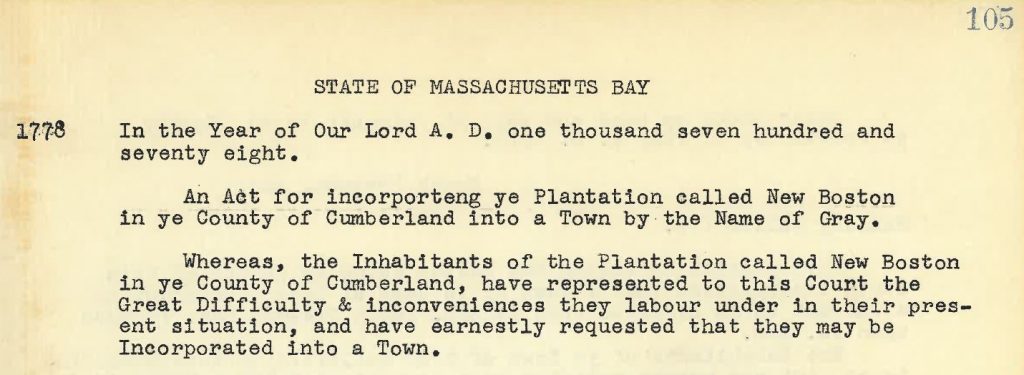
A glimpse into the earliest days of the Town of Gray is recorded in A History and Description of New England, General and Local by Austin Jacobs Coolidge and John Brainard Mansfield.
Gray is situated in the central part of Cumberland county, and was originally owned by inhabitants of Boston, to whom it was granted December 3, 1735, upon petition of the general court of Massachusetts, representing that they had large families and were in straitened circumstances. Several years intervened before a settlement of the township could be effected; but in the mean time there were frequent meetings of the proprietors in Boston, generally held at the Sun Tavern, and sometimes at the British Coffee-house. One of the first settlers – probably the first – was Moses Twitchell who came from Westboro, Mass. Jabez Matthews and William Webster followed soon after; and in the course of fifteen or twenty hears, several other families moved in. In 1756, the proprietors made a report of the progress of the settlement to the legislature, in which they state that they had laid out sixty-three lots of sixty acres each for settling lots, had built a meeting-house, erected thirty-six dwelling-houses, and cleared a part of the lands as required by the conditions of the grant; but that they had been put to great expense and suffering.
The settlers were in constant fear of hostile Indians, who at one time came upon the settlement in great numbers, destroyed the cattle, burnt the meeting-house and all the dwelling-houses, and obliged the settlers to flee to places of safety. After peace was concluded with the Indians, some of the inhabitants returned and erected a new meeting-house, as well as a block-house, fifty feet long and twenty-five feet wide, around which they erected a garrison, one hundred feet long and seventy-five feet wide, which was supplied with military stores. Soon after, a rumor of war with France terrified the settlers and they fled the second time; but the fort was not altogether forsaken, and, gradually, families obtained sufficient confidence to venture to take up a permanent abode here. At first the township was without a name, being known only as a proprietory lying on the back of North Yarmouth, in the county of York. About the year 1756, it began to be called New Boston. In 1778, by act of legislature, it was incorporated and called Gray, as it is supposed, in honor of Thomas Gray, one of the proprietors.
The book History, Records, and Recollections of Gray Maine by George T. Hill provides additional comment on the naming of the town:
There is uncertainty as to why the name Gray was given to the town when it was incorporated. A number of publications state, “it was named for Thomas Gray, one of the proprietors.” and this is the generally accepted view. Although not originally a proprietor, Thomas Gray became one before the town was incorporated and letters addressed to him asking for assistance indicate that he either held some executive position for the Proprietors or was one of that body who had been found sympathetic to the needs of the settlers. Also, it has been said that he won the gratitude of the townspeople by donating windows for the First Parish Church. Still, doubt has persisted, and in a history published in 1864 one finds the statement, “it was incorporated and called Gray, as it is supposed, in honor of Thomas Gray, one of the proprietors.”
Remarks bearing on the naming of the town are found in the papers of Mrs. Caroline (Libby) Doughty who was a granddaughter of Daniel Cummings, the first white male child born in the settlement. Daniel was born in 1766. Caroline was born in Gray on December 3, 1846, and she and the families of her ancestors were active in the religious societies that evolved from the First Parish Church; she was sent to school in Rhode Island and later served as Supervisor of Schools in Gray. Mrs. Doughty had a liking for local history and an excellent memory. Her recollections are not to be dismissed lightly, and the following pertinent paragraph appears in a paper that was probably first read by her before the Gray Grange in the 1920’s. This audience would have been extremely critical of material contradictory to the folklore of that era.”
There is a tradition that when the first church was built there was no money with which to procure windows, and that the Hon. Billy Gray of Boston, a wealthy generous public spirited merchant, brother of Thomas Gray who was one of the proprietors of New Boston, was interested in the township and hearing of this need donated windows for the meeting-house. Thus in his honor the town was named Gray.”
The author has been unable to confirm either of the above views and will leave this subject with the conclusion that the town was either named for Thomas Gray or for one of his relatives.
